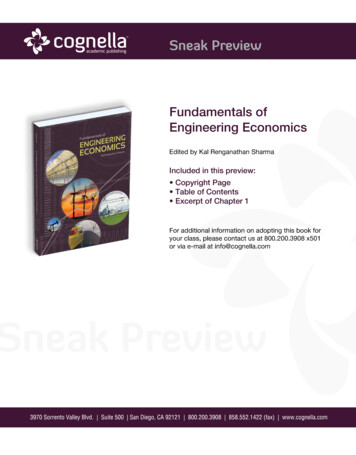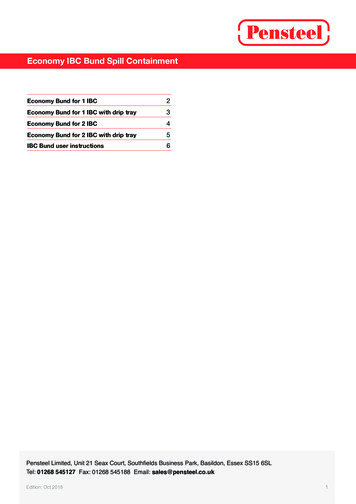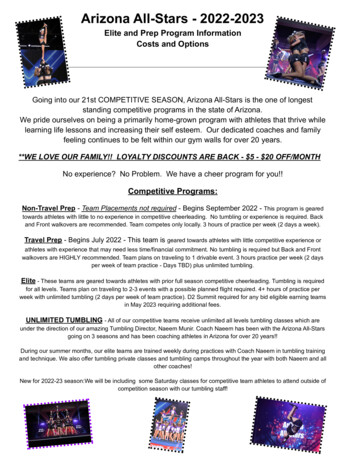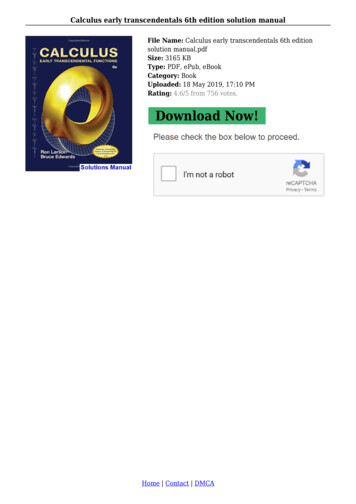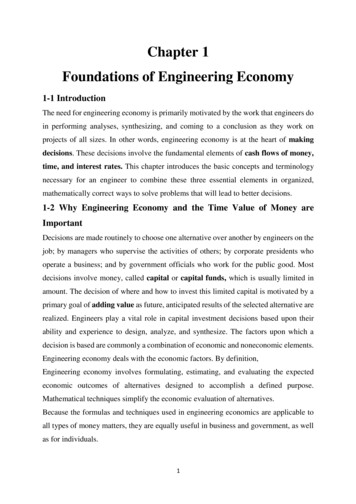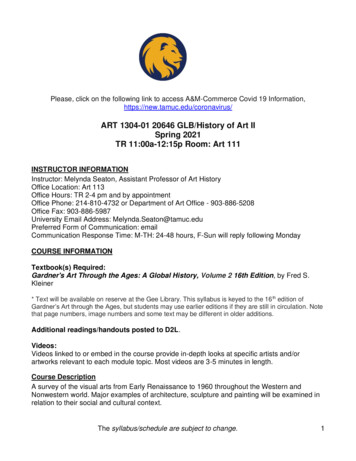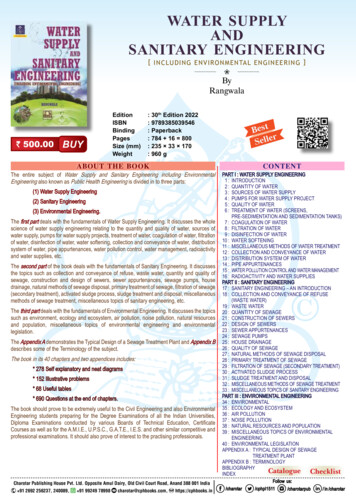
Transcription
Engineering economy 16th edition solution manual pdf 2019
Add a review and share your thoughts with other readers. Be the first. Add a review and share your thoughts with other readers. Be the first. Instructor Solutions Manual for Engineering Economy, 16/EWilliam G. Sullivan, Virginia Polytechnic Institute and State UniversityElin M Wicks, Abacus Accounting, LLCC. Patrick Koelling, Virginia PolytechnicInstitute and State UniversityC Patrick Koelling, Virginia Polytechnic Institute and State University productFormatCode W22 productCategory 12 statusCode 5 isBuyable false subType next path/ProductBean/courseSmart ISBN-10: 0133439291 ISBN-13: 978013343929897801334392989780133439298 2015 Pearson OnlinePublished 03/28/2014 Live prodCategory : 12 statusCode : 5About ThisProductDownloadResourcesPackages Preface (PDF) Next Edition(s)Next EditionsInstructor's Solutions Manual for Engineering Economy, 17/ESullivan, Wicks, Koelling & KoellingISBN-10: 0134870158 ISBN-13: 9780134870151 2019 Online LiveMore infoInstructor'sSolutions Manual for Engineering Economy, 17/ESullivan, Wicks, Koelling & KoellingISBN-10: 0134870158 ISBN-13: 9780134870151 2019 Online LiveMore info Pearson Higher Education offers special pricing when you choose to package your text with other student resources. If you're interested in creating a cost-saving package for yourstudents contact your Pearson Higher Education representative. Share the publicationSave the publication to a stackLike to get better recommendationsThe publisher does not have the license to enable download By visiting our site, you agree to our privacy policy regarding cookies, tracking statistics, etc. Read more You're Reading a Free PreviewPages 5 to 9 are not shown in this preview. Table of contents : Cover.Page 1Title Page.Page 8Contents.Page 10Preface.Page 16Green Content.Page 23CHAPTER 1Introduction to Engineering Economy.Page 28 1.1 Introduction.Page 29 1.2 The Principles of Engineering Economy.Page 30 1.3 Engineering Economy and theDesign Process.Page 34 1.5 Try Your Skills.Page 42 1.6 Summary.Page 43CHAPTER 2Cost Concepts and Design Economics.Page 47 2.1 Cost Terminology.Page 48 2.2 The General Economic Environment.Page 54 2.3 Cost-Driven Design Optimization.Page 65 2.4 Present Economy Studies.Page 70 2.5 CASE STUDY—TheEconomics of Daytime Running Lights.Page 76 2.6 Try Your Skills.Page 78 2.7 Summary.Page 79 Appendix 2-A Accounting Fundamentals.Page 87CHAPTER 3Cost-Estimation Techniques.Page 94 3.1 Introduction.Page 95 3.2 An Integrated Approach.Page 97 3.3 Selected Estimating Techniques (Models).Page 105 3.4Parametric Cost Estimating.Page 110 3.5 CASE STUDY—Demanufacturing of Computers.Page 121 3.6 Electronic Spreadsheet Modeling: Learning Curve.Page 123 3.7 Try Your Skills.Page 125 3.8 Summary.Page 127CHAPTER 4The Time Value of Money.Page 134 4.1 Introduction.Page 135 4.2 Simple Interest.Page 136 4.4The Concept of Equivalence.Page 137 4.5 Notation and Cash-Flow Diagrams and Tables.Page 140 4.6 Relating Present and Future Equivalent Valuesof Single Cash Flows.Page 144 4.7 Relating a Uniform Series (Annuity) to Its Presentand Future Equivalent Values.Page 150 4.8 Summary of Interest Formulas and Relationshipsfor DiscreteCompounding .Page 160 4.9 Deferred Annuities (Uniform Series).Page 162 4.10 Equivalence Calculations Involving MultipleInterest Formulas.Page 164 4.11 Uniform (Arithmetic) Gradient of Cash Flows.Page 170 4.12 Geometric Sequences of Cash Flows.Page 175 4.13 Interest Rates that Vary with Time.Page 180 4.14 Nominal andEffective Interest Rates.Page 182 4.15 Compounding More Often than Once per Year.Page 184 4.16 Interest Formulas for Continuous Compoundingand Discrete Cash Flows.Page 187 4.17 CASE STUDY—Understanding Economic “Equivalence”.Page 190 4.18 Try Your Skills.Page 193 4.19 Summary.Page 196CHAPTER 5Evaluatinga Single Project.Page 213 5.1 Introduction.Page 214 5.2 Determining the Minimum Attractive Rateof Return (MARR) .Page 215 5.3 The Present Worth Method.Page 216 5.4 The Future Worth Method.Page 223 5.5 The Annual Worth Method.Page 224 5.6 The Internal Rate of Return Method.Page 229 5.7 The External Rate ofReturn Method†.Page 240 5.8 The Payback (Payout) Period Method.Page 242 5.9 Case Study—A Proposed Capital Investmentto Improve Process Yield.Page 245 5.10 Electronic Spreadsheet Modeling:Payback Period Method.Page 247 5.11 Try Your Skills.Page 249 5.12 Summary.Page 251 Appendix 5-A The Multiple Rate of ReturnProblemwith the IRR Method.Page 263CHAPTER 6Comparison and Selection among Alternatives.Page 267 6.2 Basic Concepts for Comparing Alternatives.Page 268 6.3 The Study (Analysis) Period.Page 272 6.4 Useful Lives Are Equal to the Study Period.Page 274 6.5 Useful Lives Are Unequal among the Alternatives.Page 291 6.6Personal Finances.Page 304 6.7 Case Study—Ned and Larry’s Ice Cream Company.Page 308 6.9 Project Postevaluation Spreadsheet Approach.Page 311 6.10 Try Your Skills.Page 314 6.11 Summary.Page 318CHAPTER 7Depreciation and Income Taxes.Page 335 7.2 Depreciation Concepts and Terminology.Page 336 7.3 TheClassical (Historical) Depreciation Methods.Page 339 7.4 The Modified Accelerated Cost Recovery System.Page 344 7.5 A Comprehensive Depreciation Example.Page 353 7.6 Introduction to Income Taxes.Page 357 7.7 The Effective (Marginal) Corporate Income Tax Rate.Page 360 7.8 Gain (Loss) on the Disposal of an Asset.Page363 7.9 General Procedure for MakingAfter-Tax Economic Analyses.Page 364 7.10 Illustration of Computations of ATCFs.Page 368 7.11 Economic Value Added.Page 380 7.12 Try Your Skills.Page 382 7.13 Summary.Page 383CHAPTER 8Price Changes and Exchange Rates.Page 395 8.1 Introduction.Page 396 8.2 Terminology andBasic Concepts.Page 397 8.3 Fixed and Responsive Annuities.Page 403 8.4 Differential Price Changes.Page 408 8.5 Spreadsheet Application.Page 410 8.6 Foreign Exchange Rates and PurchasingPower Concepts.Page 412 8.7 Case Study—Selecting Electric Motors to Power an Assembly Line.Page 417 8.8 Try Your Skills.Page420 8.9 Summary.Page 421CHAPTER 9Replacement Analysis.Page 430 9.2 Reasons for Replacement Analysis.Page 431 9.3 Factors that Must Be Consideredin Replacement Studies.Page 432 9.4 Typical Replacement Problems.Page 435 9.5 Determining the Economic Life of a NewAsset (Challenger).Page 438 9.6 Determining theEconomic Life of a Defender.Page 442 9.7 Comparisons in Which the Defender’s Useful LifeDiffers from that of the Challenger.Page 445 9.8 Retirement without Replacement (Abandonment).Page 448 9.9 After-Tax Replacement Studies.Page 449 9.10 Case Study—Replacement of a Hospital’s Emergency Electrical Supply System.Page457 9.11 Summary.Page 460CHAPTER 10Evaluating Projects with the Benefit Cost Ratio Method.Page 470 10.1 Introduction.Page 471 10.2 Perspective and Terminology for AnalyzingPublic Projects.Page 472 10.4 Multiple-Purpose Projects.Page 473 10.5 Difficulties in Evaluating Public-Sector Projects.Page 476 10.6 What InterestRate Should Be Usedfor Public Projects?.Page 477 10.7 The Benefit Cost Ratio Method.Page 479 10.8 Evaluating Independent Projects by B C Ratios.Page 485 10.9 Comparison of Mutually Exclusive Projectsby B C Ratios.Page 487 10.10 Case Study—Improving a Railroad Crossing.Page 492 10.11 Summary.Page 494CHAPTER11Breakeven and Sensitivity Analysis.Page 502 11.2 Breakeven Analysis.Page 503 11.3 Sensitivity Analysis.Page 510 11.4 Multiple Factor Sensitivity Analysis.Page 516 11.5 Summary.Page 520CHAPTER 12Probabilistic Risk Analysis.Page 529 12.1 Introduction.Page 530 12.3 The Distribution of Random Variables.Page 53112.4 Evaluation of Projects with DiscreteRandom Variables.Page 535 12.5 Evaluation of Projects with ContinuousRandom Variables.Page 544 12.6 Evaluation of Risk and Uncertaintyby Monte Carlo Simulation.Page 549 12.7 Performing Monte Carlo Simulationwith a Computer.Page 553 12.8 Decision Trees.Page 557 12.9 Real OptionsAnalysis.Page 562 12.10 Summary.Page 565CHAPTER 13The Capital Budgeting Process.Page 573 13.1 Introduction.Page 574 13.2 Debt Capital.Page 576 13.3 Equity Capital.Page 577 13.4 TheWeighted Average Cost of Capital (WACC).Page 580 13.5 Project Selection.Page 584 13.6 Postmortem Review.Page 588 13.7Budgeting of Capital Investmentsand Management Perspective.Page 589 13.8 Leasing Decisions.Page 590 13.9 Capital Allocation.Page 592 13.10 Summary.Page 598CHAPTER 14Decision Making Considering Multiattributes.Page 602 14.2 Examples of Multiattribute Decisions.Page 603 14.4 Selection of a MeasurementScale.Page 605 14.6 Noncompensatory Models.Page 606 14.7 Compensatory Models.Page 611 14.8 Summary.Page 619Appendix A Using Excel to Solve Engineering EconomyProblems.Page 625APPENDIX B Abbreviations and Notation.Page 642Appendix C Interest and Annuity Tables for DiscreteCompounding.Page 646AppendixD Interest and Annuity Tables for ContinuousCompounding.Page 665Appendix E Standard Normal Distribution.Page 669Appendix F Selected References.Page 672Appendix G Solutions to Try Your Skills.Page 675 A.Page 687 C.Page 688 D.Page 689 E.Page 690 I.Page 691 M.Page 692 P.Page 693 R.Page 694S.Page 695 V.Page 696 W.Page 697 Citation preview Engineering Economy For these Global Editions, the editorial team at Pearson has collaborated with educators across the world to address a wide range of subjects and requirements, equipping students with the best possible learning tools. This Global Edition preserves the cutting-edgeapproach and pedagogy of the original, but also features alterations, customization, and adaptation from the North American version. sixteenth edition Pearson Global Edition Sullivan Wicks Koelling This is a special edition of an established title widely used by colleges and universities throughout the world. Pearson published this exclusive editionfor the benefit of students outside the United States and Canada. If you purchased this book within the United States or Canada you should be aware that it has been imported without the approval of the Publisher or Author. Global edition Global edition Global edition ISBN-13: 978-1-292-01949-9 ISBN-10: 1-292-01949-2 9 0 0 0 0 9 781292 019499Engineering Economy sixteenth edition William G. Sullivan Elin M. Wicks C. Patrick Koelling Abbreviations and Notation Summary CHAPTER 4 APR annual percentage rate (nominal interest) EOY end of year f a geometric change from one time period to the next in cash flows or equivalent values i effective interest rate per interest period r nominalinterest rate per period (usually a year) CHAPTER 5 AW(i%) equivalent uniform annual worth, computed at i% interest, of one or more cash flows CR(i%) equivalent annual cost of capital recovery, computed at i% interest CW(i%) capitalized worth (a present equivalent), computed at i% interest FW(i%) future equivalent worth, calculated at i%interest, of one or more cash flows EUAC(i%) equivalent uniform annual cost, calculated at i% interest IRR internal rate of return, also designated i% MARR minimum attractive rate of return N length of the study period (usually years) PW(i%) present equivalent worth, computed at i% interest, of one or more cash flows CHAPTER 6 (B A)incremental net cash flow (difference) calculated from the cash flow of Alternative B minus the cash flow of Alternative A (read: delta B minus A) “cvr suli9274 16 se ifc” — 2013/11/9 — 9:42 — page 1 — #1 CHAPTER 7 ATCF after-tax cash flow BTCF before-tax cash flow EVA economic value added MACRS modified accelerated cost recovery systemNOPAT net operating profit after taxes WACC tax-adjusted weighted average cost of capital CHAPTER 8 A actual (current) dollars f general inflation rate R real (constant) dollars CHAPTER 9 EUAC equivalent uniform annual cost TCk total (marginal) cost for year k CHAPTER 12 E(X) mean of a random variable f (x) probability density function of acontinuous random variable p(x) probability mass function of a discrete random variable SD(X) standard deviation of a random variable V(X) variance of a random variable CHAPTER 13 CAPM capital asset pricing model RF risk-free rate of return SML security market line Xj binary decision variable in capital allocation problems“cvr suli9274 16 se ifc” — 2013/11/9 — 9:42 — page 2 — #2 Right now, in your course, there are young men and women whose engineering achievements could revolutionize, improve, and sustain future generations. Don’t Let Them Get Away. Engineering Economy, 16th Edition, together with MyEngineeringLab, is a complete solution for providingan engaging in-class experience that will inspire your students to stay in engineering, while also giving them the practice and scaffolding they need to keep up and be successful in the course. Learn more at myengineeringlab.com “a01 suli9499 16 se fm” — 2014/3/18 — 14:39 — page 1 — #1 “a01 suli9499 16 se fm” — 2014/3/18 — 14:39 — page 2— #2 ENGINEERING ECONOMY Sixteenth Edition Global Edition “a01 suli9499 16 se fm” — 2014/3/18 — 14:39 — page 3 — #3 “a01 suli9499 16 se fm” — 2014/3/18 — 14:39 — page 4 — #4 ENGINEERING ECONOMY SIXTEENTH EDITION GLOBAL EDITION WILLIAM G. SULLIVAN ELIN M. WICKS C. PATRICK KOELLING Virginia PolytechnicInstitute and State University Wicks and Associates, L.L.P. Virginia Polytechnic Institute and State University Global Edition contributions by Anisha Sharma Upper Saddle River Boston Columbus San Francisco New York Indianapolis London Toronto Sydney Singapore Tokyo Montreal Dubai Madrid Hong Kong Mexico City Munich Paris AmsterdamCape Town “a01 suli9499 16 se fm” — 2014/3/18 — 14:39 — page 5 — #5 Vice President and Editorial Director, ECS: Marcia J. Horton Executive Editor: Holly Stark Editorial Assistant: Carlin Heinle Director of Operations: Nick Sklitsis Executive Marketing Manager: Tim Galligan Marketing Assistant: Jon Bryant Senior Managing Editor: ScottDisanno Production Project Manager: Gregory Dulles Head of Learning Asset Acquisitions, Global Edition: Laura Dent Publishing Operations Director, Global Edition: Angshuman Chakraborty Manager, Publishing Operations, Global Edition: Shokhi Shah Khandelwal Associate Print and Media Editor, Global Edition: Anuprova Dey ChowdhuriAcquisitions Editor, Global Edition: Sandhya Ghoshal Publishing Administrator, Global Edition: Hema Mehta Project Editor, Global Edition: Daniel Luiz Editorial Assistant, Global Edition: Sinjita Basu Operations Specialist: Linda Sager Photo Researcher: Marta Samsel Image Permission Coordinator: Karen Sanatar Text Permission Coordinator:Michael Farmer Cover Designer: Karen Noferi Cover Photo Credit: Shutterstock/Zadorozhnyi Viktor Cover Printer: Courier Westford Full-Service Project Management: Pavithra Jayapaul Pearson Education Limited Edinburgh Gate Harlow Essex CM20 2JE England and Associated Companies throughout the world Visit us on the World Wide Web at:www.pearsonglobaleditions.com Pearson Education Limited 2014 The rights of William G. Sullivan, Elin M. Wicks, and C. Patrick Koelling to be identified as the authors of this work have been asserted by them in accordance with the Copyright, Designs and Patents Act 1988. Authorized adaptation from the United States edition, entitledEngineering Economy, 16th edition, ISBN 978-0-13-255490-9, by William G. Sullivan, Elin M. Wicks, and C. Patrick Koelling, published by Pearson Education 2014. All rights reserved. No part of this publication may be reproduced, stored in a retrieval system, or transmitted in any form or by any means, electronic, mechanical, photocopying,recording or otherwise, without either the prior written permission of the publisher or a license permitting restricted copying in the United Kingdom issued by the Copyright Licensing Agency Ltd, Saffron House, 6–10 Kirby Street, London EC1N 8TS. All trademarks used herein are the property of their respective owners. The use of any trademark inthis text does not vest in the author or publisher any trademark ownership rights in such trademarks, nor does the use of such trademarks imply any affiliation with or endorsement of this book by such owners. ISBN 10: 1-29-201949-2 ISBN 13: 978-1-29-201949-9 British Library Cataloguing-in-Publication Data A catalogue record for this book isavailable from the British Library 10 9 8 7 6 5 4 3 2 1 14 13 12 11 10 Typeset in 10/12 Palatino by Pavithra Jayapaul, Jouve India Private Limited. Printed and bound by Courier Westford in The United States of America. “a01 suli9499 16 se fm” — 2014/3/18 — 14:39 — page 6 — #6 CONTENTS Preface Green Content 13 20 CHAPTER 1 Introductionto Engineering Economy 1.1 1.2 1.3 1.4 1.5 1.6 Introduction The Principles of Engineering Economy Engineering Economy and the Design Process Using Spreadsheets in Engineering Economic Analysis Try Your Skills Summary 25 26 27 31 39 39 40 CHAPTER 2 Cost Concepts and Design Economics 2.1 Cost Terminology 2.2 The General EconomicEnvironment 2.3 Cost-Driven Design Optimization 2.4 Present Economy Studies 2.5 Case Study—The Economics of Daytime Running Lights 2.6 Try Your Skills 2.7 Summary Appendix 2-A Accounting Fundamentals 44 45 51 62 67 73 75 76 84 CHAPTER 3 Cost-Estimation Techniques 3.1 3.2 3.3 3.4 3.5 3.6 3.7 3.8 Introduction An Integrated ApproachSelected Estimating Techniques (Models) Parametric Cost Estimating Case Study—Demanufacturing of Computers Electronic Spreadsheet Modeling: Learning Curve Try Your Skills Summary 91 92 94 102 107 118 120 122 124 7 “a01 suli9499 16 se fm” — 2014/3/18 — 14:39 — page 7 — #7 8 CONTENTS CHAPTER 4 The Time Value of Money 4.14.2 4.3 4.4 4.5 4.6 4.7 4.8 4.9 4.10 4.11 4.12 4.13 4.14 4.15 4.16 4.17 4.18 4.19 Introduction Simple Interest Compound Interest The Concept of Equivalence Notation and Cash-Flow Diagrams and Tables Relating Present and Future Equivalent Values of Single Cash Flows Relating a Uniform Series (Annuity) to Its Present and Future EquivalentValues Summary of Interest Formulas and Relationships for Discrete Compounding Deferred Annuities (Uniform Series) Equivalence Calculations Involving Multiple Interest Formulas Uniform (Arithmetic) Gradient of Cash Flows Geometric Sequences of Cash Flows Interest Rates that Vary with Time Nominal and Effective Interest RatesCompounding More Often than Once per Year Interest Formulas for Continuous Compounding and Discrete Cash Flows Case Study—Understanding Economic “Equivalence” Try Your Skills Summary 131 132 133 134 134 137 141 147 157 159 161 167 172 177 179 181 184 187 190 193 CHAPTER 5 Evaluating a Single Project 5.1 5.2 IntroductionDetermining the Minimum Attractive Rate of Return (MARR) 5.3 The Present Worth Method 5.4 The Future Worth Method 5.5 The Annual Worth Method 5.6 The Internal Rate of Return Method 5.7 The External Rate of Return Method 5.8 The Payback (Payout) Period Method 5.9 Case Study—A Proposed Capital Investment to Improve Process Yield5.10 Electronic Spreadsheet Modeling: Payback Period Method 5.11 Try Your Skills 5.12 Summary Appendix 5-A The Multiple Rate of Return Problem with the IRR Method “a01 suli9499 16 se fm” — 2014/3/18 — 14:39 — page 8 — #8 210 211 212 213 220 221 226 237 239 242 244 246 248 260 CONTENTS 9 CHAPTER 6 Comparison and Selectionamong Alternatives 6.1 6.2 6.3 6.4 6.5 6.6 6.7 6.8 6.9 6.10 6.11 Introduction Basic Concepts for Comparing Alternatives The Study (Analysis) Period Useful Lives Are Equal to the Study Period Useful Lives Are Unequal among the Alternatives Personal Finances Case Study—Ned and Larry’s Ice Cream Company Postevaluation of Results ProjectPostevaluation Spreadsheet Approach Try Your Skills Summary 264 265 265 269 271 288 301 305 308 308 311 315 CHAPTER 7 Depreciation and Income Taxes 7.1 7.2 7.3 7.4 7.5 7.6 7.7 7.8 7.9 7.10 7.11 7.12 7.13 Introduction Depreciation Concepts and Terminology The Classical (Historical) Depreciation Methods The Modified Accelerated CostRecovery System A Comprehensive Depreciation Example Introduction to Income Taxes The Effective (Marginal) Corporate Income Tax Rate Gain (Loss) on the Disposal of an Asset General Procedure for Making After-Tax Economic Analyses Illustration of Computations of ATCFs Economic Value Added Try Your Skills Summary 332 333 333 336 341350 354 357 360 361 365 377 379 380 CHAPTER 8 Price Changes and Exchange Rates 8.1 8.2 8.3 8.4 8.5 8.6 8.7 8.8 8.9 Introduction Terminology and Basic Concepts Fixed and Responsive Annuities Differential Price Changes Spreadsheet Application Foreign Exchange Rates and Purchasing Power Concepts Case Study—Selecting Electric Motors toPower an Assembly Line Try Your Skills Summary “a01 suli9499 16 se fm” — 2014/3/18 — 14:39 — page 9 — #9 392 393 394 400 405 407 409 414 417 418 10 CONTENTS CHAPTER 9 Replacement Analysis 9.1 9.2 9.3 9.4 9.5 9.6 9.7 9.8 9.9 9.10 9.11 Introduction Reasons for Replacement Analysis Factors that Must Be Considered in ReplacementStudies Typical Replacement Problems Determining the Economic Life of a New Asset (Challenger) Determining the Economic Life of a Defender Comparisons in Which the Defender’s Useful Life Differs from that of the Challenger Retirement without Replacement (Abandonment) After-Tax Replacement Studies Case Study—Replacement of aHospital’s Emergency Electrical Supply System Summary 427 428 428 429 432 435 439 442 445 446 454 457 CHAPTER 10 Evaluating Projects with the Benefit Cost Ratio Method 10.1 10.2 10.3 10.4 10.5 10.6 10.7 10.8 10.9 10.10 10.11 Introduction Perspective and Terminology for Analyzing Public Projects Self-Liquidating Projects MultiplePurpose Projects Difficulties in Evaluating Public-Sector Projects What Interest Rate Should Be Used for Public Projects? The Benefit Cost Ratio Method Evaluating Independent Projects by B C Ratios Comparison of Mutually Exclusive Projects by B C Ratios Case Study—Improving a Railroad Crossing Summary 467 468 469 470 470 473 474 476482 484 489 491 CHAPTER 11 Breakeven and Sensitivity Analysis 11.1 11.2 11.3 11.4 11.5 Introduction Breakeven Analysis Sensitivity Analysis Multiple Factor Sensitivity Analysis Summary “a01 suli9499 16 se fm” — 2014/3/18 — 14:39 — page 10 — #10 499 500 500 507 513 517 CONTENTS 11 CHAPTER 12 Probabilistic Risk Analysis 12.1 12.212.3 12.4 12.5 12.6 12.7 12.8 12.9 12.10 Introduction Sources of Uncertainty The Distribution of Random Variables Evaluation of Projects with Discrete Random Variables Evaluation of Projects with Continuous Random Variables Evaluation of Risk and Uncertainty by Monte Carlo Simulation Performing Monte Carlo Simulation with a ComputerDecision Trees Real Options Analysis Summary 526 527 528 528 532 541 546 550 554 559 562 CHAPTER 13 The Capital Budgeting Process 13.1 13.2 13.3 13.4 13.5 13.6 13.7 13.8 13.9 13.10 Introduction Debt Capital Equity Capital The Weighted Average Cost of Capital (WACC) Project Selection Postmortem Review Budgeting of Capital Investmentsand Management Perspective Leasing Decisions Capital Allocation Summary 570 571 573 574 577 581 585 586 587 589 595 CHAPTER 14 Decision Making Considering Multiattributes 14.1 14.2 14.3 14.4 14.5 14.6 14.7 14.8 Introduction Examples of Multiattribute Decisions Choice of Attributes Selection of a Measurement Scale Dimensionality of theProblem Noncompensatory Models Compensatory Models Summary “a01 suli9499 16 se fm” — 2014/3/18 — 14:39 — page 11 — #11 599 600 600 602 602 603 603 608 616 12 CONTENTS Appendix A Appendix B Appendix C Appendix D Appendix E Appendix F Appendix G Using Excel to Solve Engineering Economy Problems Abbreviations andNotation Interest and Annuity Tables for Discrete Compounding Interest and Annuity Tables for Continuous Compounding Standard Normal Distribution Selected References Solutions to Try Your Skills Index “a01 suli9499 16 se fm” — 2014/3/18 — 14:39 — page 12 — #12 622 639 643 662 666 669 672 684 PREFACE We live in a sea of economicdecisions. —Anonymous About Engineering Economy A succinct job description for an engineer consists of two words: problem solver. Broadly speaking, engineers use knowledge to find new ways of doing things economically. Engineering design solutions do not exist in a vacuum but within the context of a business opportunity. Given that everyproblem has multiple solutions, the issue is, How does one rationally select the design with the most favorable economic result? The answer to this question can also be put forth in two words: engineering economy. Engineering economy provides a systematic framework for evaluating the economic aspects of competing design solutions. Just asengineers model the stress on a support column, or the thermodynamic response of a steam turbine, they must also model the economic impact of their recommendations. Engineering economy—what is it, and why is it important? The initial reaction of many engineering students to these questions is, “Money matters will be handled by someone else.They are not something I need to worry about.” In reality, any engineering project must be not only physically realizable but also economically affordable. Understanding and applying economic principles to engineering have never been more important. Engineering is more than a problem-solving activity focusing on the development of products,systems, and processes to satisfy a need or demand. Beyond function and performance, solutions must also be viable economically. Design decisions affect limited resources such as time, material, labor, capital, and natural resources, not only initially (during conceptual design) but also through the remaining phases of the life cycle (e.g., detaileddesign, manufacture and distribution, service, retirement and disposal). A great solution can die a certain death if it is not profitable. MyEngineeringLab is now available with Engineering Economy, 16/e and provides a powerful homework and test manager which lets instructors create, import, and manage online homework assignments, quizzes,and tests that are automatically graded. You can choose from a wide range of assignment options, 13 “a01 suli9499 16 se fm” — 2014/3/18 — 14:39 — page 13 — #13 14 PREFACE including time limits, proctoring, and maximum number of attempts allowed. The bottom line: MyEngineeringLab means less time grading and more time teaching. Algorithmic-generated homework assignments, quizzes, and tests that directly correlate to the textbook. Automatic grading that tracks students’ results. Assignable Spreadsheet Exercises that students can complete in an Excelsimulated environment. Interactive “Help Me Solve This” tutorials provide opportunity for point-ofuse help and morepractice. Learning Objectives mapped to ABET outcomes provide comprehensive reporting tools. If adopted, access to MyEngineeringLab can be bundled with the book or purchased separately. What’s New to This Edition? The basic intent behind this revision of the text is to integrate computer technology and realistic examples to facilitate learningengineering economy. Here are the highlights of changes to the sixteenth edition: There are more integrated videos keyed to material in the text and designed to reinforce learning through analogy with marked problems and examples. Many new spreadsheet models have been added to the sixteenth edition (several contributed by JamesA. Alloway). This edition contains over 900 examples, solved problems and end-of-chapter problems. These include 70 “Try Your Skills” problems in selected chapters, with full solutions given in Appendix G. Over 160 “green” examples and problems populate this edition as a subset of 750 problems at the conclusion of the 14 chapters in this book.Many of these problems incorporate energy conservation in commonly experienced situations with which students can identify. PowerPoint visual aids for instructors have been expanded and enhanced. Chapter 2, dealing with choice among alternatives when the time value of money can be ignored, has been revised for improved readability. Optionalstudent resources include MyEngineeringLab with Pearson e-text, a complete on-line version of the book. It allows highlighting, note taking, and search capabilities. This resource permits access to the Video Solutions files which accompany this text as well as additional study materials. All end-ofchapter problems with this icon [ ] indicate theavailability of some form of Video Solutions. Strategies of This Book This book has two primary objectives: (1) to provide students with a sound understanding of the principles, basic concepts, and methodology of engineering economy; and (2) to help students develop proficiency with these methods and with “a01 suli9499 16 se fm” — 2014/3/18 —14:39 — page 14 — #14 PREFACE 15 the process for making rational decisions they are likely to encounter in professional practice. Interestingly, an engineering economy course may be a student’s only college exposure to the systematic evaluation of alternative investment opportunities. In this regard, Engineering Economy is intended to serve as atext for classroom instruction and as a basic reference for use by practicing engineers in all specialty areas (e.g., chemical, civil, computer, electrical, industrial, and mechanical engineering). The book is also useful to persons engaged in the management of technical activities. As a textbook,
Engineering economy 16th edition solution manual pdf 2019. Add a review and share your thoughts with other readers. Be the first. . (PDF) Next Edition(s)Next EditionsInstructor's Solutions Manual for Engineering Economy, 17/ESullivan, Wicks, Koelling & KoellingISBN-10: 0134870158 ISBN-13: 9780134870151 2019 Online LiveMore .
